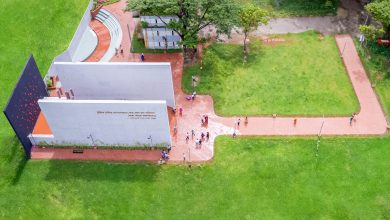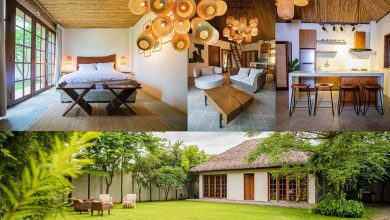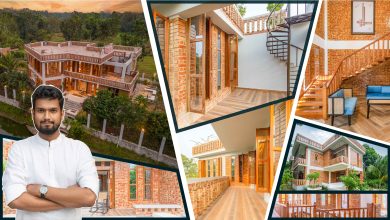Located in Gazipur, the Karotoa Green Spinning Mills is a complex that houses more than just the factory. Inside is a large man-made lake that separates the factory side from the rest of the establishments located inside the compound. That lake is the focal point of the rest-house affectionately named River Villa. River Villa was designed as a getaway for the Director, Dr. Akil Ahad who regularly uses the villa when he is in Gazipur. Set within an expansive 130-bigha estate, Karotoa Green Spinning Mills emerges not only as a center of industrial productivity but as a model of integrated spatial design that balances functionality with modern architectural aesthetics. The visual story captured reveals an environment where careful planning, sustainability, and human comfort intersect.

The main entrance gate of the compound is a bold, symmetrical composition that sets the tone for what lies beyond. Flanked by solid white walls and landscaped green borders, the large, central metal gate is colored in a muted golden beige—conveying security and solidity. The finish of the gate appears to be matte, minimizing reflectivity and giving a clean, sophisticated presence.

To the left, a striped green panel façade houses a security checkpoint or admin booth. The vertical green lines alternate between rich hunter green and soft olive, suggesting a rhythm and depth in texture. The branding, “Karotoa Green,” is elegantly embedded in the surface with sleek, metallic white lettering and a minimalist logo. This careful typography reinforces the company’s clean, forward-looking identity. This entrance reads less like a conventional factory gate and more like the front face of a modern campus, where branding and design sensibility are seamlessly woven into security and access control.

The two-story residential structure within the compound, identified as River Villa, a dedicated living facility designed like a modern resort. This building is elegant, practical, and contextually aware. With sharp geometric lines, cantilevered balconies, and expansive glazing, it echoes a boutique hospitality structure rather than a utilitarian residential block.

The architectural language is grounded in horizontal lines and volumetric layering.

The form is broken into clear sections, where each zone is treated with sensitivity to privacy and openness. The balconies with glass railings are among the most visually dominant features, suggesting transparency, connection to nature, and unobstructed views of the expansive lawn and beyond.

River Villa hosts five bedrooms, a sprawling terrace, a gym and a sitting room with an unparalleled view of the lake. The rooms are airy and bright, fashioned like modern hotel rooms with ample light and floor-to-ceiling windows that promote natural ventilation, courtesy of the lake. The colours used are warm, earthy and soothing that matches perfectly with the overall theme of River Villa.

The façade uses a well-balanced three-tone color scheme: A rich earthy terracotta brown forms the central mass of the building, grounding the structure in a natural, warm tone. A crisp off-white or light gray plaster finish wraps around the secondary volumes and structural framing adding brightness and visual clarity. The black steel columns and balcony supports provide contrast and structural rhythm, while dark aluminum or UPVC-framed windows and doors reinforce the contemporary detailing. The materials suggest a hybrid of reinforced concrete frame construction with masonry infill walls, finished with a combination of textured plaster and modern cladding. The integration of glass, metal, and smooth masonry adds layers of both visual and tactile interest.




The surrounding lawn is a well-kept, semi-wild green carpet, speaking to the scale of the property and the desire to keep the building immersed in a natural setting. The steps leading to the entrance are wide, ceramic-tiled, and gently elevated, offering a welcoming gesture.
A glimpse into the interior of the residence reveals a refined and minimalist design aesthetic.
The focal point is a jewel-toned velvet sofa in deep teal, adorned with three plush pillows in a slightly darker, textured fabric. Brushed gold trimmings, adding an element of understated luxury that contrasts beautifully with the otherwise neutral-toned space.
The flooring of polished cream-colored high-gloss ceramic tile, reflecting ample daylight that streams in from large glazed windows and a pair of glass doors. The flooring enhances the sense of space and also ties in with the building’s exterior off-white walls, creating a consistent visual flow between inside and out.
The large window with white-painted metal grills offers a secure yet open outlook. The grill design is modern, with clean horizontal lines that allow natural light to enter freely while ensuring safety. On the right, full-length glass doors framed in matte black aluminum or powder-coated steel lead directly to the outside lawn, blurring the boundary between indoor and outdoor space.
The interior walls are smooth, painted in a light off-white or warm beige, which further amplifies the natural light and ensures that the furniture stands out. The electrical fittings are minimal and modern, and a subtle light switch panel is visible, matching the clean lines of the room. This space radiates a sense of tranquility and comfort, ideal for visiting guests, senior staff, or perhaps even executive retreats within the factory compound.
Karotoa Green Spinning Mills is particularly compelling in the holistic integration of industrial, residential, and environmental functions within a single master plan.


The design does not isolate the living or aesthetic elements from the manufacturing function, it embraces them. The use of wide lawns, controlled color palettes, contemporary structures, and a sense of proportion gives the space an almost campus-like or institutional quality rather than an industrial one.
Even the rest houses and accommodation facilities, though not pictured, are reportedly constructed with similar attention to aesthetics and comfort. When an industrial complex makes such deliberate architectural choices, from the branding signage at the entrance to the quality of furniture inside a living unit—it sends a clear message: workplace design is also about dignity, identity, and legacy.
Karotoa Green Spinning Mills is a rare confluence of design, purpose, and philosophy.



Instead of approaching the compound as merely a site of production, the developers have infused it with values of beauty, sustainability, and care. The modern design aesthetic rooted in simplicity, material honesty, and sensitivity to both human and environmental needs raises the bar for industrial architecture in the region.



